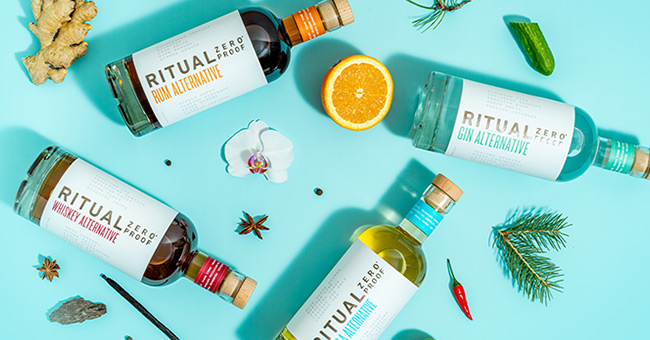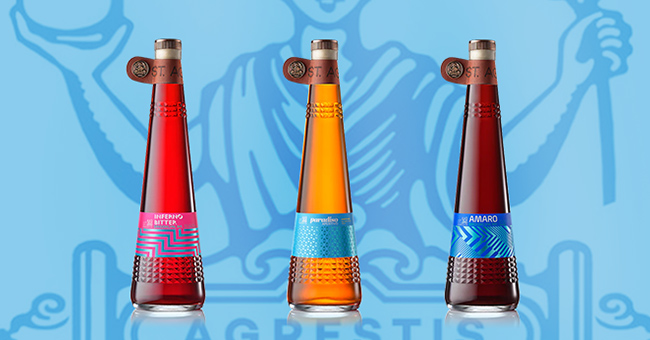
Will the Chili’s menu of the future feature a non-alcoholic margarita? Marcus Sakey, co-founder of Ritual Zero Proof, is betting on it.
“We are well past the niche phase, these aren’t niche consumers, it’s not a niche product, but it hasn’t hit the general acceptance that it’s going to,” he said.
Sakey is among the entrepreneurs in the no- and low-alcohol space who are benefitting from the recent demand for alcohol alternatives. Ritual, a line of four spirit alternatives, has been named the fastest-growing non-alcoholic spirits brand on Nielsen. But where are no-alcohol spirits headed and what other innovations will come out on top?
With “better for you” alternative beverages on the rise, no- and low-alcohol has grown from $7.8 billion in 2018 to nearly $10 billion in 2021 across various markets globally, with volume growth expected to outpace regular alcohol, according to beverage data company the IWSR.
New non-alcoholic beverage specialty retailers have emerged during the pandemic to meet that rising demand. After launching in Brooklyn in 2020, Boisson now operates five retail stores in New York City, and recently announced the opening of three storefronts in Los Angeles. The company will pass eight-figures in revenue by the end of this year, and will likely finish 2022 at around 7x-8x revenue, with 50% of the business driven by e-commerce, said Nick Bodkins, founder and CEO.
While wine and ready-to-drink beverages are the leading categories at Boisson, there are a few defining characteristics among best selling products across the spectrum.
“What seems to stand out is quality and innovation: creating a product that inspires the consumer to experiment and then rewards them when they do,” Bodkins said.

Top spirit sellers include Aplós, a hemp-infused non-alcoholic spirit that positions its “calming and uplifting” attributes in opposition to the “negative effects of alcohol”; spiritless Kentucky 74, which encourages going “halfsies”, a way of low-alc drinking by using a 1:1 split between their product and a full-alcohol bourbon; and AMASS Riverine, a distilled botanical with a distinct flavor that can be supplemented for a gin in cocktails.
According to Arlenia Garcia, co-founder of online retailer The Mindful Drinking Co., other growing non-alc categories include functional adult beverages that offer wellness attributes and work in a variety of settings, like Kin Euphoric (co-founded by model Bella Hadid) and Three Spirit US. There’s also tequila alternatives, to which Garcia attributes consumer interest to the popularity of its traditional counterpart, particularly in cocktails. One of the biggest hurdles for customers new to no-alcohol spirits is knowing what to do with them, he said — which is why no-alcohol tequila provides an intuitive solution.
At Whole Foods Market, beer or beer-adjacent items like hop water are driving the most growth according to Mary Guiver, Global Senior Category Merchant for Beer and Spirits. But while it’s a small niche category, zero-proof spirits are outpacing growth in almost all other spirit categories at the natural grocery chain, joining RTDs as the other top trending category.
“So when you merge these top two trends into one, and see the potential of non-alc RTDs starting to come into focus, I expect this category to continue to expand as consumers become aware of it, and more suppliers bring products to the market,” said Guiver.
Full blown replacement tequila and whiskey spirits in 750 ml formats are among the leading no-alcohol spirit options at Whole Foods Market. But as suppliers experiment with different RTD bases from dealcoholized spirits to water or juice, and as customers discover the category, Guiver is keeping an eye on which approach wins out over time.
“I attribute the success of specific brands and formats to taste and price point—it’s one thing to produce an item you can celebrate as non-alc, but if it doesn’t taste good, it’s already a failure,” she said.

To Guiver, non-alcoholic RTDs emulating spirit-based RTDs are boosting the RTD category as a whole, creating a kaleidoscope of options. At Boisson, no-alcohol RTDs are playing the same role as they do for alcohol drinkers, with brands like the Phony Negroni from St. Agrestis and Ghia spritzes among the top sellers.
“People love the variety of fun RTDs—they’re delicious, convenient, and easy to share or pack with you,’ said Bodkins.
While Diageo’s acquisition of Seedlip in 2019 seemed to signal the category’s move into the mainstream, much of the “sober curious” movement has blossomed during the pandemic— which means sales and educational opportunities now lie in on-premise and other channels that have reopened since lockdowns.
Boisson is now working with on-premise customers, who Bodkins said are overwhelmed with the options and unaware of what customers want. The company is also launching an app to connect drinkers with local restaurants and bars that sell the products they’re buying from Boisson. Meanwhile, Mindful Drinking is finding success through placement in gyms, spas and corporate gifting. In-person events are key, as Garcia still finds plenty of customers who are skeptical about the flavors of replacement spirits.

“I think that there’s still a lot of room for growth in the coming years and within the space— people are just starting to learn about it and exploring and trying to understand a little bit more about the options that are available to them,” she said.
Meanwhile, Sakey is looking to make inroads into more mainstream on-and off-premise channels. In his mind, large chain restaurants are missing an opportunity to upsell a non-drinker from a soft drink to a non-alcoholic margarita.
“I think that’s really the next trend, right now you’ve got the more artistic end of the spectrum and you’re going to see mass adoption on-prem with some of these large chains,” he said.
The brand is also launching in CVS stores in 11 states, which Sakey views as the beginning of mainstream retail carving out sections similar to dairy or gluten-free alternative aisles. That might bode well for no-alcohol products that have opted to add stabilizers and preservatives to their products to avoid refermentation and extend shelf-life, many of which aren’t allowed in consumable products at markets like Whole Foods.
As the category expands, Guliver noted retailers’ next challenge will be determining where category boundaries lie; for instance, what qualifies as a non-alc RTD and what qualifies as a juice with cocktail inspired flavors that should live in a grocery aisle.
“It’s a major gray area that we are all exploring collectively,” she said.